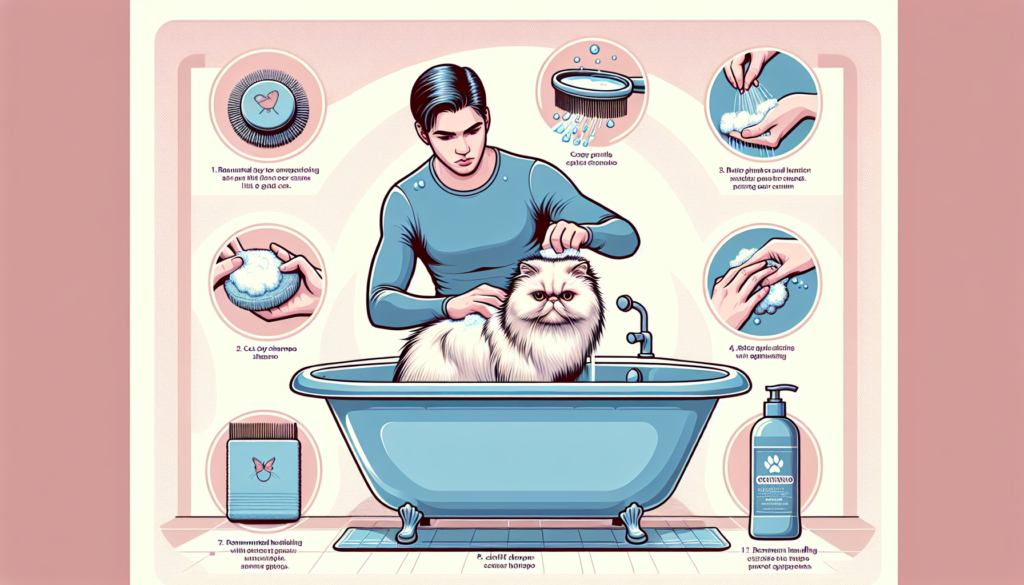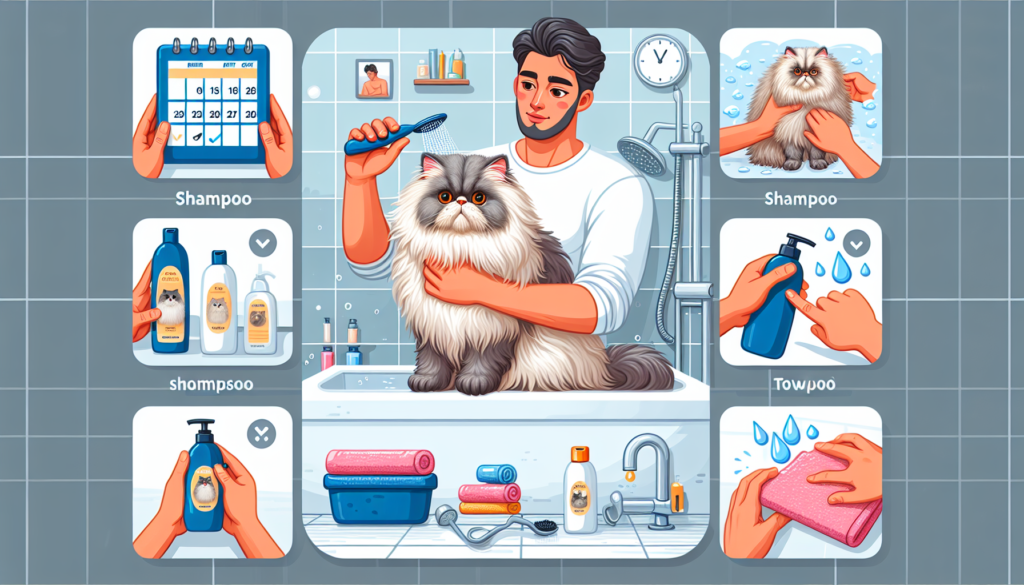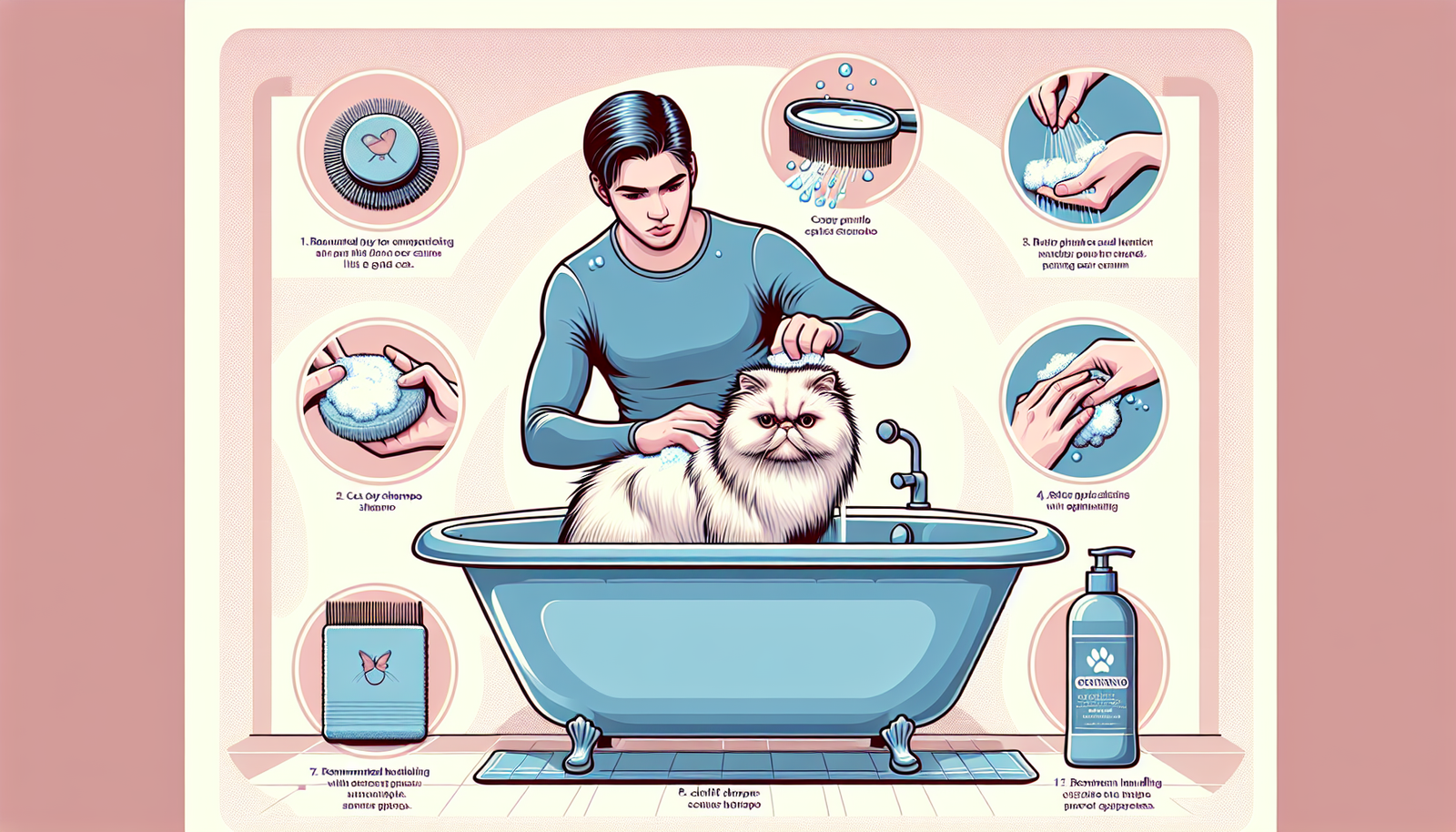You’ve got a fluffy and majestic Persian cat at home, but it seems to be in need of a good bath. Don’t fret! In “The Ultimate Guide: How to Bathe a Persian Cat,” we will walk you through the steps to ensure a stress-free and successful bathing experience for both you and your feline friend. From preparing the essentials to mastering the art of gentle handling, this guide will equip you with all the necessary knowledge to keep your Persian cat looking and feeling fresh. So, get ready to pamper your furry companion and let’s dive into this comprehensive guide on how to bathe a Persian cat.
Preparing for the Bath
Gathering the Necessary Supplies
Before you begin the bathing process, it’s important to gather all the necessary supplies. This ensures that you have everything within reach and helps create a smooth bathing experience for both you and your Persian cat. The supplies you will need include a cat-friendly shampoo, warm water, towels, a brush, nail clippers, ear cleaning solution, and eye protection. By having these items ready beforehand, you can focus on the task at hand without any interruptions.
Creating a Calm Environment
To ensure a stress-free bathing experience for your Persian cat, it’s essential to create a calm and relaxing environment. Choose a quiet and comfortable space where you can bathe your cat without any distractions. Clear the area of any objects that may cause accidents or injure your cat. Soft lighting and soothing music can help create a serene atmosphere. Additionally, it’s advisable to place a non-slip mat in the bathing area to prevent any accidents due to slippery surfaces. Remember, a calm environment is key to ensuring a positive bathing experience for your furry friend.
Brushing the Cat
Choosing the Right Brush
Before bathing your Persian cat, it’s important to brush their coat thoroughly. This helps remove any tangles or mats and prevents them from getting worse when wet. Choosing the right brush for your cat’s coat is crucial. Persian cats have long, luxurious fur that requires gentle care. A wide-toothed comb or a slicker brush are ideal choices for brushing a Persian cat’s coat. These brushes help remove loose hair and debris, while also keeping the coat looking neat and tangle-free.
Brushing the Coat
Once you have the right brush, begin by gently brushing your Persian cat’s coat in the direction of hair growth. Take your time and be extra gentle, especially when brushing around sensitive areas such as the face, ears, and belly. Be mindful of any tangles or mats and use your fingers or a comb to gently work through them. Regular brushing not only keeps your cat’s coat healthy and shiny but also reduces the amount of hair that may end up in the water during the bath.

Trimming the Nails
Getting the Appropriate Tools
Trimming your Persian cat’s nails is an essential part of their grooming routine. To do this safely and effectively, you will need appropriate nail clippers designed specifically for cats. Avoid using regular scissors or human nail clippers, as they may cause injury or discomfort to your furry friend. Opt for clippers that are specifically designed for cats, with sharp, curved blades that make the trimming process quick and easy. It’s also helpful to have styptic powder or cornstarch on hand in case of any accidental nail bleeds.
Trimming the Nails Safely
Before attempting to trim your cat’s nails, it’s important to get them comfortable with the process. Start by gently handling their paws and gradually introducing the clippers. Be patient and reward your cat with treats or praise to establish a positive association with nail trimming. When trimming, be cautious not to cut the quick, which is the pink part of the nail that contains blood vessels and nerves. Trim only the white tip of the nail, taking small, gradual cuts. If you are unsure, it’s always best to consult a professional groomer or veterinarian for guidance.
Protecting the Ears and Eyes
Using Ear Cleaning Solution
Maintaining your Persian cat’s ear hygiene is crucial for their overall health. Ears can accumulate dirt, wax, and debris, which can lead to infections if not properly cleaned. Using an ear cleaning solution specifically formulated for cats helps keep their ears clean and free from bacteria. Gently hold your cat’s ear flap and pour a small amount of the solution into the ear canal. Massage the base of the ear for a few seconds to allow the solution to penetrate, and then use a clean cotton ball or pad to wipe away any dirt or excess solution. Repeat the process for the other ear, ensuring that you do not insert anything deep into the ear canal.
Applying Eye Protection
Persian cats are known for their beautiful, large eyes, which require special care during bathing. To protect your cat’s eyes from getting wet or irritated, it’s advisable to apply eye protection. Use a small amount of petroleum jelly or a cat-friendly eye ointment and gently apply it around the eye area, creating a protective barrier. This will help prevent water and shampoo from entering the eyes, reducing the risk of discomfort or potential eye infections. When applying the eye protection, be careful not to get any product directly into your cat’s eyes.

Wetting the Cat
Using Warm Water
When it’s time to wet your Persian cat, it’s important to use lukewarm water. The water temperature should be comfortable for your cat, similar to their body temperature. Cold water may cause unnecessary discomfort, while hot water can scald their sensitive skin. Fill a basin or sink with warm water, checking the temperature with your hand or a thermometer to ensure it’s just right. It’s also essential to maintain a calm and reassuring demeanor while proceeding with this step, as your cat may be wary of the water.
Gradually Wetting the Coat
Before fully immersing your Persian cat in the water, it’s advisable to wet their coat gradually. Use a handheld showerhead or a cup to pour warm water over their body, starting from the back and moving towards the head. Be gentle and ensure that the water reaches the skin to thoroughly wet the coat. Avoid wetting the head and face at this stage as it may cause unnecessary stress. Gradually introducing your cat to the water helps them acclimate and reduces the chances of them resisting or becoming anxious during the bath.
Applying Shampoo
Selecting a Cat-friendly Shampoo
Using a cat-friendly shampoo is essential when bathing your Persian cat. Regular human shampoos can be harsh and may strip the natural oils from their coat, leading to dryness and skin irritation. Opt for a shampoo specially formulated for cats, preferably one that is hypoallergenic and gentle. These shampoos are designed to maintain the pH balance of your cat’s skin and coat. It’s advisable to consult with your veterinarian to determine the best shampoo for your Persian cat, especially if they have any specific skin conditions or allergies.
Properly Applying the Shampoo
When applying the shampoo, start by pouring a small amount into your hand. Gently work the shampoo into a lather and apply it to your cat’s coat, starting from the neck and moving towards the tail. Massage the shampoo into their fur, being careful to avoid the head and face. Take your time and be thorough while working the shampoo through the entire coat, ensuring that it reaches the skin. This process not only cleanses the fur but also helps stimulate blood circulation and keeps the coat healthy. Rinse your hands thoroughly after applying the shampoo to avoid any accidental ingestion.
Rinsing the Cat
Thoroughly Rinsing the Coat
After applying the shampoo, it’s time to rinse off the product from your Persian cat’s coat. Proper rinsing is crucial to prevent any residue from remaining on the fur, which could cause skin irritation or discomfort. Using lukewarm water, begin by gently pouring water over their body, starting from the neck and moving towards the tail. Pay close attention to areas such as the underbelly and paws, as shampoo residue can easily accumulate there. Continue rinsing until the water runs clear, indicating that all the shampoo has been thoroughly washed away. Ensure that you rinse your cat’s fur with care to avoid getting water in their ears or eyes.
Ensuring No Soap Residue
Once you have completed rinsing your Persian cat, it’s important to double-check that there is no soap residue left on their coat. Soap residue can lead to skin irritation or dryness, so thorough rinsing is crucial. Use your hands to gently run through their fur, feeling for any remains of shampoo. If you detect any greasy or slippery textures, it indicates that there is still soap present. In such cases, rinse the area again with lukewarm water until all traces of shampoo are gone. Double-checking for any remaining soap residue helps ensure that your cat’s skin stays healthy and irritation-free.
Drying the Cat
Using Towels for Initial Drying
Once your Persian cat is thoroughly rinsed, it’s time to dry their coat. Start by gently wrapping them in a soft towel to absorb the excess water. Avoid vigorous rubbing, as it can tangle the fur or cause discomfort to your cat. Instead, gently press the towel against their body and pat the fur dry. You can also wrap your cat in the towel for a few minutes to allow the fabric to absorb more water. If necessary, you can use multiple towels to ensure efficient drying. Remember, patience and a gentle touch are key to making your cat feel comfortable during this process.
Utilizing a Blow Dryer
To ensure your Persian cat’s fur is completely dry, consider utilizing a blow dryer. However, it’s important to use the blow dryer on the lowest heat setting to prevent overheating or skin burns. Gradually introduce your cat to the sound and sensation of the blow dryer, starting from a distance and slowly bringing it closer if they are comfortable. Keep the blow dryer in constant motion to prevent any areas from overheating and to ensure even drying. While using the blow dryer, continue to monitor your cat’s behavior for signs of discomfort or anxiety. If your cat shows any signs of distress, discontinue using the blow dryer and opt for air-drying instead.
Handling Challenging Situations
Dealing with a Cat’s Resistance
It’s not uncommon for cats, including Persian breeds, to resist or dislike the bathing process. If your cat shows signs of resistance, it’s essential to remain calm and patient. Avoid forcing your cat into the water, as this may cause further distress and potentially harm both you and your furry friend. Instead, try using positive reinforcement techniques such as treats, praise, or a favorite toy to motivate and reward your cat for their cooperation. Gradually introduce them to the bathing process, starting with short sessions and gradually increasing the duration over time. If your cat consistently resists bathing, consider seeking assistance from a professional groomer who specializes in handling difficult cats.
Addressing Anxiety or Fear
Some Persian cats may experience anxiety or fear during the bathing process. It’s crucial to create a safe and reassuring environment to minimize their stress. Utilize towels or mats to provide a non-slip surface, which helps them feel more secure. Playing soft, calming music or using pheromone sprays, specifically designed for cats, can also help reduce anxiety. If your cat remains fearful, it may be helpful to consult with a veterinarian or a feline behaviorist to develop strategies to manage their anxiety. Remember, understanding and respecting your cat’s feelings during bathing is of utmost importance to maintain their trust and well-being.
Maintaining Regular Bathing
Establishing a Bathing Schedule
Once you have successfully bathed your Persian cat, it’s important to establish a regular bathing schedule to keep their coat and skin healthy. The frequency of baths depends on your cat’s individual needs, but generally, bathing once every 4 to 6 weeks is sufficient for most cats. Regular baths help remove dirt, excess oil, and dead skin cells, ensuring a clean and shiny coat. However, over-bathing can strip the natural oils from their fur, leading to dryness and skin irritation. It’s crucial to find a balance that suits your cat’s needs while considering their overall health and lifestyle.
Considering Professional Grooming
While bathing your Persian cat at home is possible and can strengthen the bond between you and your furry friend, professional grooming is also an option worth considering. Professional groomers are experienced in handling cats, especially those resistant to baths, and can provide specialized care that ensures a stress-free grooming experience. They have access to high-quality products and equipment specifically designed for cat grooming. Professional grooming also allows for a thorough assessment of your cat’s coat and skin, identifying any potential issues or abnormalities. Whether you choose to groom your cat at home or opt for professional services, maintaining regular grooming sessions is essential for the overall health and well-being of your Persian cat.
In conclusion, bathing a Persian cat requires careful preparation, patience, and a gentle touch. By gathering the necessary supplies, creating a calm environment, and understanding the specific needs of your Persian cat, you can ensure a positive bathing experience for both you and your furry friend. From brushing and trimming to protecting the ears and eyes, each step plays a vital role in maintaining the health and hygiene of your cat. Remember to handle challenging situations with compassion and to establish a regular bathing schedule to keep your Persian cat looking and feeling their best.

